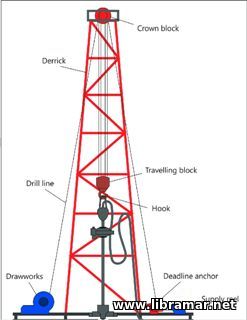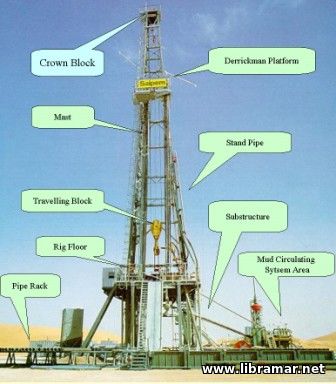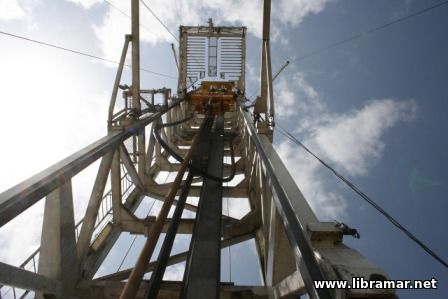Introduction to the Offshore Rig Hoisting System

In the previous article we have been acquainted with the very basics of the power system of the offshore drilling rig. And now, let us have a look at another fundamental system of any rig - the hoisting system. It is also one of the most important systems without which no drilling could be done.
The system serves a purpose of lifting the whole drill stem in drilled hole and out of it in the process of making a new well and lowering the casing down. This system itself is made of several elements, namely the substructure, the derrick (in some cases there can be the mast instead) and the drawworks, then the crown block and the traveling block equipped with the hook, and of course the drilling line.
The substructure of any rig is specifically designed and constructed to be able to effectively support the weight of the derrick taken together with the rotary table and the load of the drill stem when it is either suspended or standing in the derrick. Note that the substructure shall provide the support to the casing string during the time when they run the casing.
Moreover, its height raises the rig floor thus allowing for enough space under the rig floor to place the large valves - so-called BOPs, or blowout preventers. The rig floor area normally holds the drawworks together with the driller's cabin plus the doghouse, as well as any other relevant drilling equipment.
A derrick is the steel structure supporting the drill stem or casing, the weight of which might easily reach two hundred tons or more. A standard derrick bases on four supporting legs that, in turn, rest on the huge steel substructure. The derricks are commonly assembled using piece by piece method and this process shall be fully repeated each time when a new hole is made.
Unlike the derrick arrangement, masts are generally assembled in basic units and then the masts are lowered and raised as a one single unit with each new well. It can, however, be folded, telescoped, or separated into modules to facilitate a move. The rig masts are often called jackknife masts, because when the masts are either raised and lowered, they often look like the blade of a titanic jackknife opening and closing.
The rig derricks would normally be rated per the vertical load they have been designed to and have proven to be capable to carry plus the side wind velocity they can withstand with no damage. The load bearing capacity of the modern derricks is usually somewhere between 100 to 700 tons or even more. Typical derricks are capable of  withstanding winds with the force of up to 210 km/hour having their racks full of pipe and with no need for guy wires being attached to the ground anchors.
withstanding winds with the force of up to 210 km/hour having their racks full of pipe and with no need for guy wires being attached to the ground anchors.
Talking about the derricks, they and their substructures are expected to support the whole weight of the drill stem that is suspended from the crown block as well as either resting in the rotary table or standing idle in the derrick. While the load-bearing capacity of a derrick is not directly affected by its height, subject parameter seriously limits the length of the drill stem sections that the crew members can remove from the well.
The usual height of the rig derricks is about 41-44 meters. The crown block shall be placed at the height above the derrick floor that would be sufficient to allow the withdrawal and subsequent temporary storage of the drill stem once it has been pulled from the well for changing bits or for any other practical reason.
The "Read Later" function allows you to add material to this block with just one click. Just click on the icon and read the articles that interest you at any convenient time.


